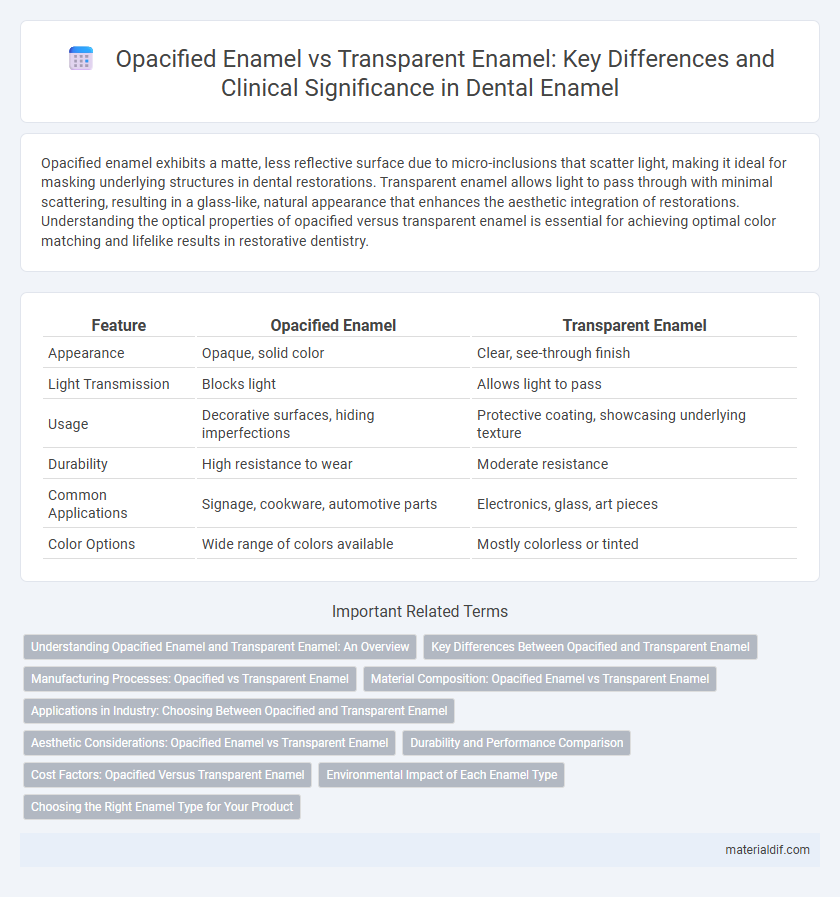Opacified enamel exhibits a matte, less reflective surface due to micro-inclusions that scatter light, making it ideal for masking underlying structures in dental restorations. Transparent enamel allows light to pass through with minimal scattering, resulting in a glass-like, natural appearance that enhances the aesthetic integration of restorations. Understanding the optical properties of opacified versus transparent enamel is essential for achieving optimal color matching and lifelike results in restorative dentistry.
Table of Comparison
| Feature | Opacified Enamel | Transparent Enamel |
|---|---|---|
| Appearance | Opaque, solid color | Clear, see-through finish |
| Light Transmission | Blocks light | Allows light to pass |
| Usage | Decorative surfaces, hiding imperfections | Protective coating, showcasing underlying texture |
| Durability | High resistance to wear | Moderate resistance |
| Common Applications | Signage, cookware, automotive parts | Electronics, glass, art pieces |
| Color Options | Wide range of colors available | Mostly colorless or tinted |
Understanding Opacified Enamel and Transparent Enamel: An Overview
Opacified enamel, characterized by its frosted appearance, contains microscopic particles that scatter light, enhancing aesthetic masking in dental restorations. Transparent enamel, in contrast, allows light to pass through with minimal scattering, mimicking the natural translucency of teeth and providing a lifelike effect. Understanding the optical properties of opacified and transparent enamel is crucial for dental professionals aiming to achieve optimal color matching and realistic tooth morphology.
Key Differences Between Opacified and Transparent Enamel
Opacified enamel contains added opacifiers like titanium dioxide to reduce translucency, resulting in a more solid, matte appearance that masks underlying surfaces and imperfections. Transparent enamel lacks these opacifiers, allowing light to pass through and creating a glossy, glass-like finish that highlights the substrate beneath. The key differences lie in their optical properties and aesthetic effects, with opacified enamel favored for concealment and durability, while transparent enamel is chosen for clarity and enhanced brightness.
Manufacturing Processes: Opacified vs Transparent Enamel
Opacified enamel manufacturing involves adding opacifiers such as tin oxide or zirconium oxide to the glass frit, creating a non-transparent, matte surface that masks underlying substrates and enhances color vibrancy. Transparent enamel is produced using clear glass frits without opacifiers, allowing the surface beneath to show through, which is ideal for decorative effects or showcasing metallic substrates. Both processes require precise control of firing temperatures, typically between 750degC and 850degC, to ensure proper adhesion and durability while maintaining the desired optical properties.
Material Composition: Opacified Enamel vs Transparent Enamel
Opacified enamel contains added opacifiers such as titanium dioxide or zirconium oxide that increase its opacity and mask underlying structures, making it ideal for dental restorations requiring color matching and concealment. Transparent enamel, composed primarily of hydroxyapatite crystals arranged with minimal impurities, allows light transmission and mimics the natural translucency of tooth enamel. The material composition differences between opacified and transparent enamel significantly influence their optical properties, durability, and application in restorative dentistry.
Applications in Industry: Choosing Between Opacified and Transparent Enamel
Opacified enamel is preferred in industries requiring decorative, opaque coatings that mask underlying surfaces and provide vibrant, consistent colors, commonly seen in cookware and signage applications. Transparent enamel is chosen for applications demanding clear, glossy finishes that enhance visibility of underlying materials, such as in electronics, automotive parts, and art glass production. The selection between opacified and transparent enamel depends on the desired aesthetic, functional properties, and specific industry requirements for durability and visual appeal.
Aesthetic Considerations: Opacified Enamel vs Transparent Enamel
Opacified enamel provides enhanced masking of underlying tooth discolorations, making it ideal for restorations requiring color correction and concealment of defects. Transparent enamel offers superior natural translucency, closely mimicking the optical properties of healthy enamel and contributing to a more lifelike appearance in dental restorations. Selecting between opacified and transparent enamel depends on the need for aesthetic masking versus achieving seamless integration with surrounding dentition.
Durability and Performance Comparison
Opacified enamel offers enhanced durability due to its ability to resist scratching, chipping, and chemical exposure, making it ideal for high-wear surfaces and protective coatings. Transparent enamel, while slightly less resistant to physical damage, excels in preserving underlying patterns and colors, providing superior visual clarity and aesthetic appeal. Both types deliver reliable performance, but opacified enamel is preferred in industrial applications requiring robust protection, whereas transparent enamel suits decorative purposes where durability is balanced with transparency.
Cost Factors: Opacified Versus Transparent Enamel
Opacified enamel contains added opacifiers such as titanium dioxide, increasing raw material costs compared to transparent enamel, which uses fewer additives and simpler formulations. Manufacturing opacified enamel requires more precise control of pigment dispersion and firing conditions, contributing to higher production expenses. Transparent enamel's lower cost stems from streamlined processing and reduced pigment usage, making it a more budget-friendly option in applications where opacity is not critical.
Environmental Impact of Each Enamel Type
Opacified enamel contains additives such as titanium dioxide that increase its environmental footprint due to energy-intensive production and potential chemical runoff during manufacturing. Transparent enamel requires fewer synthetic components, resulting in lower emissions and reduced waste in its lifecycle. Evaluating these differences highlights transparent enamel as a more eco-friendly choice in sustainable design and manufacturing processes.
Choosing the Right Enamel Type for Your Product
Opacified enamel offers superior coverage and vibrant color, making it ideal for products requiring bold, consistent finishes such as signage and decorative items. Transparent enamel enhances the underlying surface with a glossy, luminous effect, suitable for highlighting details on ceramics and jewelry. Selecting the appropriate enamel type depends on the desired visual outcome, substrate compatibility, and application method to achieve optimal durability and aesthetic appeal.
Opacified enamel vs Transparent enamel Infographic

 materialdif.com
materialdif.com